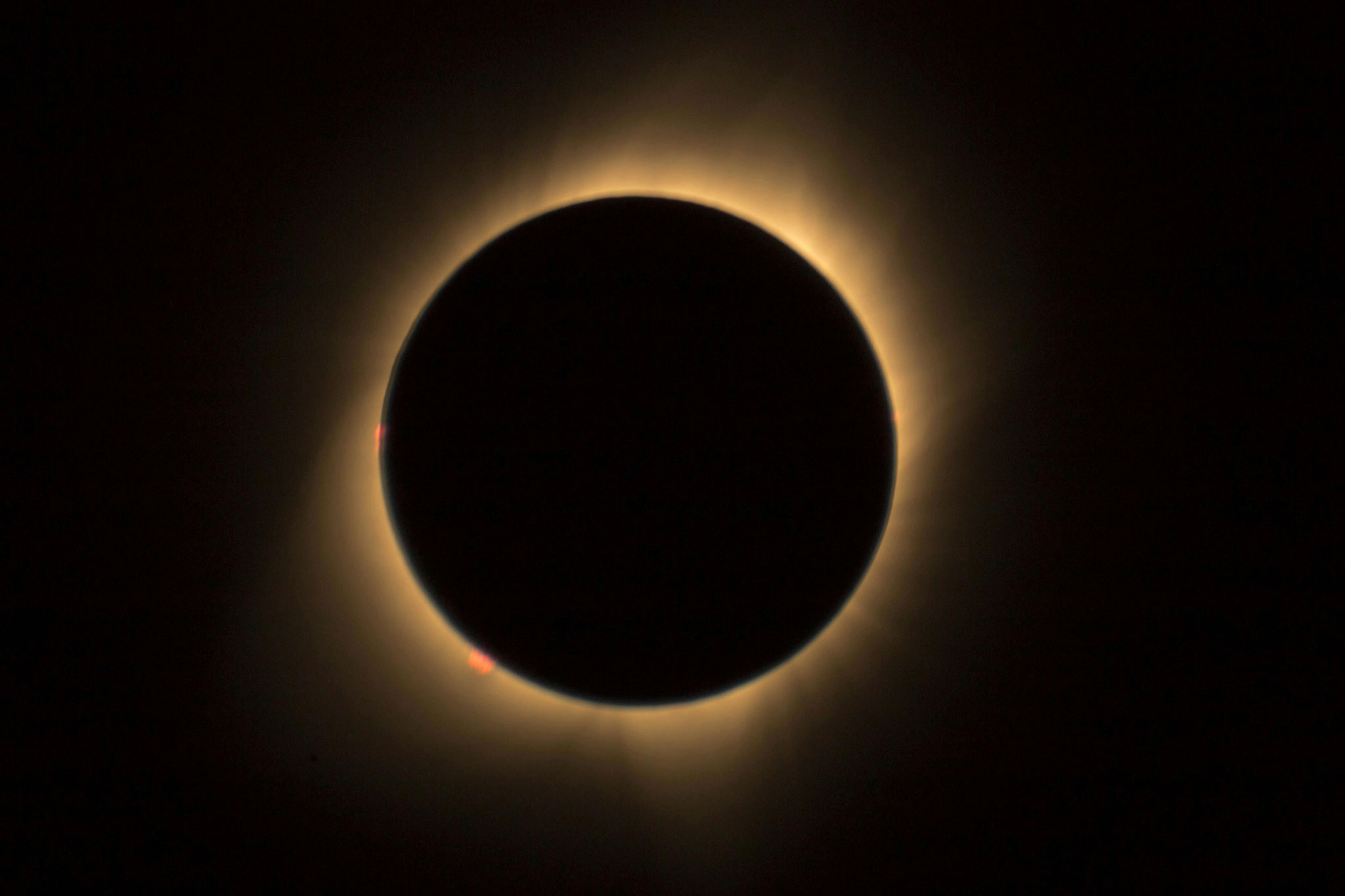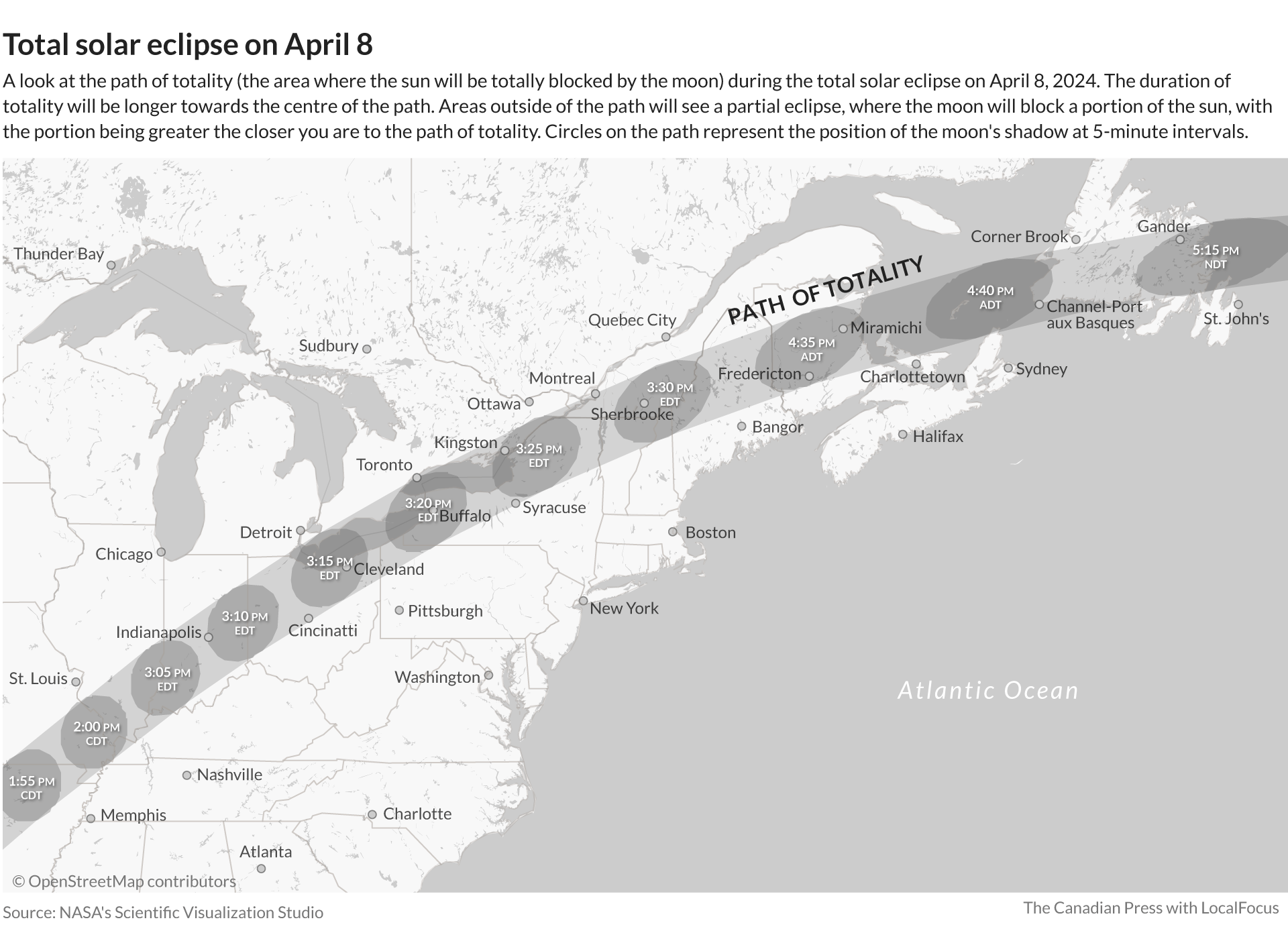Everything you need to know about the Solar Eclipse in Ontario today
Published April 8, 2024 at 8:02 am

Today (April 8), a total solar eclipse is set to fall over Ontario and parts of eastern and central Canada, bringing a short period of darkness during the afternoon.
The rare celestial event, in which the sun goes directly behind the moon, will first cross through southwestern Ontario around 3:15 p.m. and move east through Quebec and Atlantic Canada before exiting Newfoundland at around 3:45 p.m.

Here’s everything to know about the solar eclipse today:
Where to get the best view of the total solar eclipse in Ontario
Cloudy conditions in Ontario today may make it difficult to see the eclipse’s totality. Meteorologist Sean Akiyama said the best views are likely to come on the “extreme ends” of the total solar eclipse’s path through Ontario, the province’s most southwestern and eastern edges.
Southwestern Ontario, including Point Pelee National Park, are forecasted to see a mix of sun and cloud. But moving into the Hamilton-Niagara region and Toronto, the conditions get worse.
The forecast shows a thick blanket of cloud in the area, said Akiyama. While a break in that cloud cover is possible, he said it would be “pretty hard” to find a clear view.
Many people are heading to Niagara Falls to see the eclipse, creating the largest tourist crowd in Niagara Falls history. The majority of the city’s hotels are booked and people are now renting out their driveways and backyards to those who want to camp out ahead of the big day.
How to look at the eclipse safely
Anyone planning to watch the solar eclipse is reminded to use proper eye protection.
During the eclipse, the sun’s light will not be as bright as it usually is, which may lead people to believe it’s safe to stare directly at it. When you’re looking directly at the sun, intense visible light and infrared radiation are focused on the centre of the retina in the back of the eye, said Dr. Philip Hooper, president of the Canadian Ophthalmological Society.
“It’s basically like taking a magnifying glass in the sun on a normal day and focusing that light on a piece of paper. It can get hot enough to burn the paper,” Hooper said.
Regular sunglasses do not provide enough protection to look at the eclipse. Those planning to watch the eclipse should purchase safe-to-use solar glasses, which are marked with the ISO 12312-2:2015 standard. A list of approved glasses for sale is on the American Astronomical Society website. Prices range from $5 to $20.
Beware of fake solar eclipse glasses which have been popping up for sale in some places.
If you don’t have solar glasses and you’re pressed for time, you can make a pinhole camera using everyday items. A basic pinhole projector can be made by pushing a pin through a piece of paper or cardboard to create a tiny hole. When you take that paper outside and cast a shadow with it on the ground, the bit of light that passes through the hole projects “a little tiny image of the sun” and allows safe tracking of the eclipse.
“And this will work with nearly anything that you have in your house. You can use a sturdy construction board. You can use paper,” said Elaina Hyde, director of the Allan I. Carswell Observatory at Toronto’s York University.
Bizarre phenomena to expect during the eclipse
Experts say there could be a range of bizarre effects during the eclipse. Around 20 minutes before the total eclipse, it will begin to get noticeably darker, and around 30 seconds to a minute before the totality — when the moon appears to completely cover the sun — shadow bands can be observed.
“They’re like waves of light appearing on the ground, a bit like the waves of light you can observe at the bottom of a swimming pool in the sun. It’s a manifestation of the atmospheric turbulence,” said Marc Jobin, an astronomer at the Montreal Planetarium. “It’s an unusual phenomenon that can only be seen at this time.”
During the total eclipse, the temperature can suddenly drop several degrees and the wind can change direction. Clouds can also dissipate in the minutes before the total eclipse — so even if Monday starts out as a cloudy day, sky watchers may still be in luck — a phenomenon that researchers link to the cooling that occurs on Earth when the moon hides the sun.
Expect traffic jams and road closures for solar eclipse travellers to Niagara Falls
Residents should expect traffic jams, road closures and huge crowds for the total solar eclipse in Niagara Falls and across southern Ontario. The crowds may even disrupt cell service.
In Niagara Falls, police say the following roads will be closed starting at 11 a.m.:
- Morrison Street will be closed between Portage Road and River Road
- McCrae Street will be closed between Stanley Avenue and Victoria Avenue
- North Street between Main Street and Buchanan Avenue
- River Road between Morrison Street and Hiram Street
- Portage Road Between Dunn Street and McLeod Road
The following Niagara Falls roads may also be closed as needed or at 12 p.m.:
- River Road between Hiram Street and Fraser Hill
- Clifton Hill between Victoria Avenue and River Road
- Murray Hill between Fallsview Boulevard and River Road
Police forces outside of Niagara Falls are also advising drivers to be safe on the roads during the eclipse. Hamilton Police shared the following tips:
- Plan ahead to enjoy the solar eclipse. Do not stop or pull over on the roadway or shoulder to observe. Instead carefully exit the roadway and park in a safe location away from traffic.
- Anticipate the sky to darken when driving during this time, ensure your vehicle headlights are on.
When will the next solar eclipse happen?
While the next total solar eclipse in Canada is expected to pass through western provinces in 20 years, the phenomenon only happens in any given location roughly once every 360 years by some estimates.
With files from The Canadian Press
INsauga's Editorial Standards and Policies








